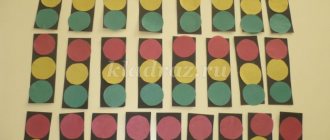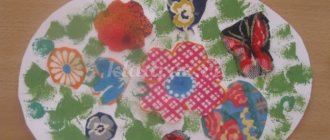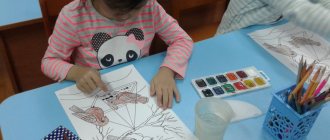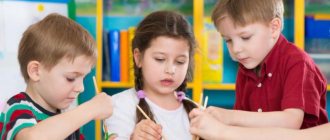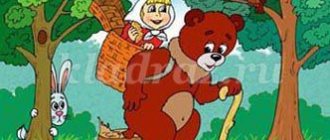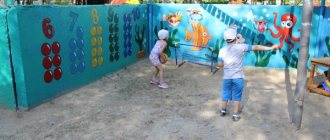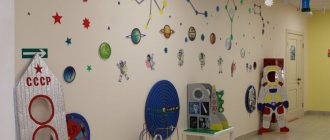Features of the middle group
In the activities of four-year-old children, an important place is occupied by teaching correct behavior at home and in public places. At the same time, they develop organization and responsibility. Teachers explain to children what to do in certain situations and what not to do. During classes and in free activities, the teacher works to develop the creative abilities of pupils in the middle group of the kindergarten.
Short stay group (STG)
As a rule, very young children from 1 to 3 years old are enrolled in the short-stay group. This service can be used by any interested parent who has submitted the necessary documents and joined the queue. Such groups work 3 times a week for 3 hours in total.
Classes there start at 8:30 and last until 11:30. There is also an evening shift from 16:00 to 19:00. It all depends on the schedule of classes at the educational institution, so always check the opening hours at your garden.
Note to parents
Most often, parents worry about at what age to send their child to kindergarten and whether it is worth doing it so early, because children from 1 to 3 years old still need their mother’s presence. It is especially difficult for parents to make a decision if this is the first baby in the family.
Staying in kindergarten is the very first and most important experience for every child. Here he learns to show his personal qualities and communicate with peers.
If we omit the details, the opinion of many experts agree on one thing: from a psychological point of view, meeting and communicating with children in a playful and relaxed manner helps the child adapt and enter society. After all, in this society the child will grow and develop, gain experience and experience different stages of personality development. And the sooner the child begins to adapt, the better it will be for his psychological health.
It should be noted that young mothers and fathers should also be prepared for such a responsible step.
And before you send your child to a short-stay group, make sure that this is exactly the place where your son or daughter will be comfortable.
Today you can quickly find reviews on the Internet about any product or service. Look for reviews and comments about your kindergarten. And you probably know mothers whose children also go to this kindergarten. You can also come to the kindergarten and see everything with your own eyes, and chat with the nannies and teachers.
What activities are conducted with children in short-stay groups?
Typically, such groups have 2 classes a week of physical education and music and once a week classes in drawing, modeling, literature and design.
It’s also not difficult to sign up for GKP groups. They are available in almost all preschool institutions. To be included in the group, you must:
- contact the head of the kindergarten with a request to enroll the child in the GKP. If there are places in the group, you will definitely be accepted;
- if there are no free places, contact the so-called “Mini-OSIP” (this is the district information support service).
- You can also sign up for the group through the city services portal
When you have found a place, you need to worry about documents for the garden. There are not many of them, but you will have to collect them quickly:
- passport of the parent or legal representative of the child;
- baby's birth certificate;
- child registration in the city;
- if you have benefits, also provide a document for inclusion in the preferential category;
Enrollment in the GKP occurs in the same way as in a regular kindergarten group. You are put on a waiting list and when a place becomes available, they call you and inform you that your child can go to kindergarten.
Procedure for enrollment in a short-stay group.
When there are few free places in a group, the head of the kindergarten must follow certain rules when enrolling a child in the group. For example, your child will be accepted faster if:
- your family (or child) lives/is registered in this area;
- preferential categories of children
If all children from this list are enrolled, then in order of priority the following are enrolled:
- children with temporary registration
- kids from other areas
A parent does not have to go to the daycare every week or month to find out if a place has become available. Typically, parents are sent an email notification or receive a call on their cell phone.
When enrolling in kindergarten, check the availability of a medical card, and immediately before enrollment you must provide:
- contacts of the child and his parents;
- complete blood count and urine test;
- analysis for enterobiasis and worm eggs
Before enrolling a child in a kindergarten group, the parent will have to sign a service agreement, which will spell out all the rights and responsibilities of both parents and teachers.
As a rule, documents of this kind protect both parties from possible claims. Therefore, every parent should not be lazy and read this agreement carefully.
Features of children staying in a short-term group
The child is not in kindergarten all day, but only for some part of the day, so meals are not provided here. But any baby can freely ask for water. So before you send your son or daughter to kindergarten, don't forget to feed him.
Adaptation in the group is quite smooth. Any parent can go to the group and see how their child feels there. This makes it easier for the baby to survive a long separation from his parents and get comfortable in a new environment. Remember also that the child’s psyche is quite vulnerable at this age, and any innovation can have a bad effect on his emotional state. But if you prepare your baby and send him to a short-term group, you can avoid negative emotions on the part of the baby.
The first days in the GKP last only half an hour for a child. Then the stay time becomes longer, but it all depends on the child’s behavior and addiction. Often educators recommend starting with half an hour and adding only 15 minutes every few days so as not to escalate the situation.
Approximate schedule for short-stay groups:
- Monday - 9:00-9:10 music games; 10:10-10:20 didactic games;
- Tuesday—10:00-10:10 movement development, 10:30-10:40—artistic creativity (drawing, modeling, appliqué, coloring must alternate here);
- Wednesday—9:00-9:10 didactic game, 10:00-10:10 speech development;
- Thursday—9:00-9:10 outdoor game; 10:00-10:10 games with building materials;
- Friday—9:10-9:20 educational game; 10:00-10:10 music game
The average monthly cost of GKP is about 1,500 rubles. However, if you have benefits, you can write an application for payment compensation (or part of the compensation).
What additional expenses does the parent expect?
Many kindergartens and groups also have additional expenses, which most often depend on the director of the kindergarten. This point should also be discussed in advance, and it is best to do this at the time of signing the contract with the garden. Although, the times when huge gatherings were held in gardens are long gone.
However, some parents face actual extortion. In this case, you should contact the anti-corruption hotline.
Middle group of kindergarten: image of a pupil
At this age the child is fully formed. Each has its own character, certain preferences and tastes. Four-year-old children are very active and want to make many friends. Often their activity confuses not only educators, but also parents. Children of four years old practically conquer one height after another. Today it was the back of the sofa, tomorrow it was the window sill, then a heated towel rail in the bathroom, a computer desk. Children want to explore everything. Often such actions are destructive. It is at such moments that many parents begin to send their children to kindergarten groups, where the children’s activities are filled with communication with peers and a variety of activities in which they can release their energy.
Junior groups for children 3-4 years old
Junior groups are open 5 days a week (Monday-Friday) from 7 am to 19:00 pm. Children aged 3 and 4 years old are enrolled in this group.
At this age, every child goes through a period of personality formation, habits and character traits are formed.
In the younger group, children get acquainted with the outside world, make new acquaintances and learn new skills. Sometimes children learn many times more in kindergarten, communicating with peers, than sitting at home with their mother.
Teachers conduct many developmental activities. This has become especially true nowadays. So children, visiting the younger group:
- recognize the world around them;
- learn correct speech;
- read fiction (in particular fairy tales and short stories);
- learn letters and numbers, get acquainted with counting;
- engaged in modeling and design;
- learn the basics of drawing and appliqué
Features of the younger group:
- at 3-4 years old, the child is already actively developing and this development is radically different from what it was in the nursery. Up to 3 years of age, children need close attention and affection, and after 3 years of age, children develop curiosity about the world around them;
- At the age of 3, children begin to show interest in group games. The child begins to become more actively acquainted with peers and communicate in society. Teachers can only help and encourage children to communicate. This is how the first independence appears.
- Many teachers and psychologists are sure that the development of children at 3 and 4 years old is the most crucial period. Let us note that it is at this age that children often suffer from colds and viral diseases when they come into contact with each other. Here you will have to be patient, because the baby’s young body is faced with many types of bacteria and viruses. But it’s a completely different matter when nannies and kindergarten teachers are negligent and the kids get sick.
- For the first time, children show their intellectual development in society. It should be noted that it is different for each baby. Some people understand faster what teachers are talking about, while others are a little slower. Here everything is in the hands of the teachers, because they must find an individual approach to each child. If you come across just such nannies and teachers, rest assured - you have chosen the right kindergarten.
- Most often, in the younger group, children acquire self-service skills: they learn to dress and undress themselves, go to the toilet and wash themselves, and even try to eat on their own;
What children learn in the younger group of kindergarten
- at this age, the child learns to dress and undress, put on and take off his shoes;
- hold cutlery and eat independently;
- they understand that they need to finish the soup and then start the second course;
- ask to use the potty, go to the toilet independently and wash their hands before and after using the toilet and playing.
Basic educational skills in the junior group:
- The child knows how to navigate around. He understands that left and right are different directions, and clothes have a front side and a back side;
- the child is oriented in the concepts of space and time. For example, a child will understand if you say: under the bed, in front of him, near the table, and so on.
- distinguishes geometric shapes: circle, square, triangle and rectangle;
- distinguishes colors;
- a child can use a model (looking at an adult) to build a pyramid from cubes of the same color, arrange objects by color;
- at this age, children strive to help adults: bring plates to the table, water or sprinkle flowers, carry a bag, etc.;
What classes are taught to children of the younger group in kindergartens?
Whatever activity the teacher conducts, it should be done in a playful way. Under no circumstances should you force your child to play or do anything. All this is necessary in order to develop a child’s interest in activities. This is how the baby develops independence and the desire to do everything as best as possible.
Features of classes in junior groups:
- At this age, the child does not yet know how to maintain concentration for a long time, therefore, classes should last no more than 15 minutes. Otherwise, you will lose the child’s attention and the baby will simply lose interest;
- At 3 years of age, the focus is on fine motor skills and motor coordination. It will be great if you allow your baby to tie his own shoelaces and fasten the buttons on his clothes;
- Children's oral speech is actively developing. Teachers read fairy tales and stories that set the child up to learn and memorize new words and phrases. It is also important to show pictures to the baby and give him the opportunity to repeat all the recently learned words;
- the child also develops his aesthetic skills through modeling and drawing;
- at the same age, physical exercises are introduced to develop flexibility, agility, endurance and speed in children;
- There is also music education, where children learn to distinguish sounds by pitch and intensity, and also become familiar with musical rhythm;
- At this time, costume performances begin to take place in the garden.
Math classes
Various activities are organized for all kindergarten students. If we talk about mathematics, it can be noted that in the younger group, educators give children basic knowledge in this area, while the middle group assumes the complication of tasks in the formation of elementary mathematical concepts. Mathematics classes include learning to distinguish the constituent parts of a certain group of objects and the formation of concepts of similarities and differences between them. The teacher develops knowledge that a group of objects is larger than the individual thing that is part of it. Already at this age, children are taught to count to ten.
Parent meeting in the middle group on the topic “Age characteristics of 4-5 years”
Provide the child with the opportunity to play together with other children
, realizing that such a game not only develops his imagination and imaginative thinking, but is also absolutely necessary for healthy emotional development. Offer the child for play not only toys that are complete in form, but also unshaped objects that do not have a clear function: pebbles, sticks, blocks, etc.
Understand that the child is already capable of doing what he likes for a long time and enthusiastically, and it can be very difficult for him to interrupt the game
, so it’s worth warning him in advance about the need to finish it.
Be open to your child's questions
, be interested in his opinion, turning his thirst for knowledge into the ability to find answers to questions that interest him. It is useful to discuss with your child any events and phenomena that interest him, and in his language to formulate the results of your joint reasoning and conclusions.
Blitz survey of parents on actively manifested characteristics in children of our group
What should a 4-5 year old child know and be able to do?
Speech development:
Correctly pronounce all the sounds of your native language;
Use nouns in speech that denote professions;
Use nouns with a general meaning: vegetables, fruits, berries, animals;
Agree words in gender, number, case;
Use sentences with homogeneous members;
Retell short literary texts, compose a story based on a plot picture, toy, objects;
Be able to answer questions based on the content of what you read;
Read short poems and nursery rhymes by heart;
Reproduce the content of works of art using the teacher’s questions.
Cognitive development:
Count within 5 (quantitative counting), answer the question “how much in total”;
Compare 2 groups of objects using counting;
Compare 5 objects of different lengths and heights, arranging them in ascending order by length and height;
Recognize and name a triangle, distinguish it from a circle and a square;
Distinguish and name parts of the day;
Determine the direction of movement from yourself (right, left, forward, backward, up, down);
Know your right and left hand;
Know and name the main parts of a building material (cube, block, plates);
Learn to analyze a building sample: identify the main parts and distinguish them by size and shape;
Be able to design from paper: bend a rectangular sheet of paper in half, matching the sides and corners;
Be able to identify the characteristics of objects (color, shape, size);
Determine the material from which the thing is made (wood, metal, paper, fabric);
Know furniture, clothing, dishes, some fruits, transport (cars, trains, planes, ships) in the immediate environment;
Speech development
The middle group of kindergarten involves planning the activities of the teacher in such a way as to give children basic knowledge of sounds and syllables, as well as sentences. In stories from personal experience, children are encouraged to use not only direct but also indirect speech. Attention is paid to ensuring that children actively use different types of complex sentences when communicating. The middle group of kindergarten involves developing skills in retelling literary works with simple plots.
Educational, developmental and training tasks
The functions of a preschool teacher are varied. Among the main ones I would like to note is ensuring the physical development of children. The teacher must promptly teach children to perform basic movements. Particular attention is paid to the formation of basic cultural and hygienic skills. The middle group of kindergarten assumes a daily routine that harmoniously fits the tasks of developing the cognitive activity of pupils. The work of a teacher involves expanding children's knowledge about people, phenomena and objects. He also teaches how to identify the features of objects through sensory examination, elementary analysis and comparison.
What does a teacher teach four-year-old children?
Pupils of the middle group develop independence skills. Classes are conducted to teach them different ways of doing things. Self-service skills are gradually developed in children. Particular attention is paid to teaching game actions. All tasks can be found in the program by finding the “Middle Group” section there. Games are presented in blocks. It is indicated which of them need to be planned during physical education classes, which ones - during a walk and during free activity. Manual labor also occupies an important place in the middle group of kindergarten. During its organization, the teacher solves many educational, developmental and educational tasks. Such activities contribute to the formation of a friendly atmosphere in the team. Manual labor in the middle group is attractive to children because it provides an opportunity to show individuality and creativity. Speech development classes are organized according to a program appropriate for a given age group. Teachers also formulate children’s ideas about a healthy lifestyle. The program for a kindergarten involves planning the activities of the teacher in such a way that it contributes to the full development of each pupil. This is possible due to compliance with the regime, which is compiled for the middle group, taking into account the characteristics of its pupils.
Age is not important, or Multi-age groups in kindergartens
From the junior group to the middle one, from there to the senior group, then to the preparatory group. This path of a preschooler is familiar and understandable to us. But it can be different when today a kindergarten student is in a group of creators, tomorrow he is in a group of researchers, and the day after tomorrow he is just reading a book and does not want to be in any group.
Tatyana Volkova talks about the best technologies and methods of working in a mixed-age group. Tatyana worked for more than 15 years in the system of preschool and school education as a practical teacher, including a teacher and methodologist in a kindergarten. The author of practical and methodological manuals on issues of preschool pedagogy, transmits domestic experience abroad, gets acquainted with foreign practices and introduces them to Russian colleagues.
Common Russian practice
In most Russian kindergartens, dividing children into groups depending on age is a normal and long-familiar practice. The path of children from the younger group to the preparatory group is the traditional path in the Russian preschool education system.
But there are exceptions to every rule. For example, in rural small kindergartens, in kindergartens working according to the Waldorf method, in short-term groups, in special, correctional, inclusive groups, as well as in home and family kindergartens, the norm is precisely a mixed-age composition.
Nowadays, the practice of organizing and working in a mixed-age group is most actively developing in family kindergartens. Over the 10 years of development of this form of education, extensive experience has been accumulated in working with children in different age groups.
Since the main methodological literature on preschool education is designed for institutions with a same-age group composition, it is quite difficult for educators working in a mixed-age group to achieve a sufficient level of knowledge and skills of children within the framework of the federal state educational standard (FSES).
The work of a teacher in a mixed-age group has its own characteristics and imposes certain requirements. For example, a teacher should
- know the programs of all age groups;
- be able to combine program requirements with the age and individual characteristics of children;
- correctly distribute attention, understand and see each child and the entire group as a whole;
- ensure the development of children in accordance with their capabilities.
The most important feature of organizing work in a mixed-age group is the priority importance of an individual approach to each child.
By organizing the joint activities of children of different ages, the teacher solves many problems associated with the pedagogical process: to teach the elders to take care of the younger ones, not to interrupt, to let the younger ones speak first, to unobtrusively help if they have difficulty completing a task. However, these difficulties constitute the advantages of raising children of different ages together: children learn much faster, imitating older children in everything, and older children become softer and more tolerant of younger ones.
Such an atmosphere can only be created in a small group, in which an individual approach is truly possible.
In a multi-age group, the teacher must vary the format of classes with children: individually, divided into subgroups or simultaneously with everyone. Individual lessons, as well as grouping into subgroups, are not always acceptable, since, for example, children in a large family are usually very friendly, and if they do something, then only all together. Accordingly, all that remains is to conduct classes simultaneously with the entire group.
When conducting such activities, an adult needs to keep all children in sight, pay attention to each, and also capture the mood of each child and his interest in this particular activity, ensuring the development of children in accordance with their age and individual capabilities.
Practice of Western Europe
There, in most preschool institutions, the educational process is organized taking into account the composition of children of different ages, and not by dividing them into age groups. And as practice shows, this approach is more effective; it allows children to more actively interact not only with their peers, but also with older and younger students, learn to build different relationships, and master different types of communications.
For example, in Germany, if the groups are of different ages, and there are not very many pupils in the kindergarten, then the children move freely around its premises.
Typically, the entire composition of children of different ages (mainly from 3 to 7 years old) is not divided into separate groups or subgroups; pupils can, at their own discretion, unite for the activities they choose or do something separately from others. Teachers are thus assigned not to a group of children, as is typical in traditional kindergartens in Russia, but to a room where children of all ages visit during the day, for example, a laboratory, library, creative workshop or gym. The main emphasis in the activities of educators is on building a space in which the child receives a variety of experiences.
If the design capacity of the kindergarten is large enough, then the limits of movement around the institution are stricter, and groups of children are often of the same age, in order to implement more optimal and rational educational work.
The premises are equipped according to the principle of “excessive sufficiency” and accessibility, that is, so that each child can independently find the necessary material or equipment.
In most preschool educational organizations in Germany, there is not a program, but an “education concept”. In theory, only the basic conceptual foundations of the organization of preschool education are developed, and in practice, accepted, and in each specific kindergarten, teachers independently decide what and how they will do in order to comply with them. A kindergarten can have from 30 to 300 students, depending on the capacity and resource equipment of a particular kindergarten. The group usually consists of 2 teachers and one assistant (assistant). According to the norm, there are from 9 to 15 children per teacher. On average, if the kindergarten is large, there are 24 children in the group. The number of working hours of the teacher is regulated by his contract with the institution. According to the 1990 law, the purpose of preschool institutions is to develop the child into an independent and socially oriented person through child care, upbringing and education.
Teachers work with children in such a way that each child develops communication skills (speech development, interaction with people, the ability to act independently or in a group of children). Much attention is paid to the formation of a system of moral values. The basics of mathematical knowledge, nature, technology (including information technology), and musical culture are given. An important place in the work of teachers is occupied by the development of children’s physical abilities, dexterity, coordination, and their ideas about a healthy lifestyle. All this is realized through the play activities of associations of different ages, in which children gather at their own request and for an arbitrary period of time.
Useful literature on the topic
In the spring of 2022, the Sfera publishing house will publish a new manual on organizing work in a mixed-age group of authors T.V. Volkova, A.S. Chervova. “Classes in a mixed-age group.” The manual will present scenarios for classes on speech development, familiarization with the outside world, the formation of elementary mathematical concepts, modeling, music, speech therapy, psychological classes and many others.
This manual will be interesting and useful for parents who want to independently raise and develop their children, parents-teachers of family and home kindergartens, teachers of preschool educational institutions, as well as all adults seeking to improve their pedagogical competence.
The activities presented in the manual will help parents and teachers of preschool educational institutions organize and conduct interesting activities, educational games and leisure activities with children of preschool age, and taking into account the characteristics of children with disabilities.
Classes are largely based on the principles of positive socialization of preschool children, focusing mainly on the development of communication skills, emotional intelligence, and personal competencies of the child through play. Classes can be easily adjusted at the discretion of parents, and can also be used in the implementation of any comprehensive and partial educational programs that kindergartens work with.
In the manuals of Volkova T.V., Chervova A.S. “Family kindergarten. Practical guide", publishing house "Iris-Press", 2011 and "Family kindergarten in the system of public education and training", publishing house "Linka-Press", 2011, in addition to the necessary material on family kindergartens, contains a large number of notes on classes with children in a different age group with links to books, workbooks, albums, etc. recommended for use in the classroom.
The publication of T.V. Volkova and T.S. Fetisova is also devoted to this topic. “Features of classes in a multi-age group of a family kindergarten magazine” // Modern preschool education Theory and Practice No. 5, 2011
Tatyana Volkova “How to raise a happy child. Features of preschool education in Germany" // School Psychologist (methodological journal for educational psychologists) Publishing House "First of September" No. 10 (535), October 2015, pp. 28 – 30
Tatyana Volkova “New solutions for creating a modern educational subject-spatial environment” // Preschool education - a methodological magazine for kindergarten teachers N12 (347), December 2015, pp. 26-31 *** With her experience in organizing work in a multi-age preschool group at Tatyana Volkova will share the basis of foreign and domestic practices at the All-Russian conference “Preschool education: the best programs, practices and technologies” .
Subscribe to the channel “School of Teachers and Directors”
Affiliate Material
Atmosphere in the middle group of kindergarten
Among the tasks that the teacher solves, a special place is occupied by the development of relationships between four-year-old children. He teaches them to coordinate actions, accept a common goal and strictly follow it. The teacher makes sure that every child is able to experience joy from the results of joint activities and treat everything around him kindly. It teaches kids to respond emotionally to the states of other people and to show kind feelings towards plants and animals. In the course of joint activities, the teacher develops children’s creative expressions and fosters interest in participating in various games. He also encourages students to engage in artistic activities, teaches them to experience success and joy from the fact that they managed to realize their plans.
How the development environment is organized
For the full development of four-year-old children, social, social, spiritual and material conditions are provided. The right equipment is essential to encourage children to engage in playful activities and develop their imagination. The subject environment can be compared to mental activity, which is why it is so important for the comprehensive development of the personality of each child. The subject environment represents the external conditions of the pedagogical process, makes it possible to properly organize the independent activities of students and contributes to their self-development under the supervision of a teacher.
